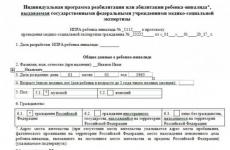Passport recharging fire extinguisher sample. How to fill out a passport for a fire extinguisher: regulatory documentation, examples and rules for filling out
Fire is the uncontrolled spread of fire, causing harm to both human life and property damage. The reasons for its occurrence are mainly careless handling of fire or. According to the technical regulation on the requirement fire safety from 09/01/2009 fires are divided into A, B, C, D, E and F class. Depending on the category, they are used in fire fighting various means and mechanisms. For example, mobile fire extinguishers are used to neutralize class A, B, C, E fires.
Preparing devices for operation
The installation site of the fire extinguisher must be inaccessible to sunlight, high temperatures, vibration loads and humidity. The main requirement during installation is the easy accessibility of the fire extinguisher in emergency. As a rule, they are placed on special ones on each required area building. Installation zones are provided for by the project or regulatory documentation on fire safety.
Fire extinguishers prepared for use must be kept ready. They should hang in accessible places, be full, with regulated pressure. Service consists of checking constituent parts, tests and a new charge of a fire extinguisher. Maintenance is carried out by a responsible person in accordance with established instruction. During visual inspection, the following items should be checked:
During or repair of defects, the devices must be replaced with spare ones. If defects are found, correct them immediately.
Paperwork
The results of maintenance are recorded in a special document - an operational passport for a fire extinguisher. It is divided into two parts. The first one is filled in by the responsible person immediately after the fire extinguisher is put into operation. From technical passport, which comes with the kit, the primary data is entered in the header of the document:
- fire extinguisher number;
- start date of use;
- brand and model;
- manufacturer;
- serial number;
- brand of charged OTV.
The places where the fire extinguisher is attached to the wall, as well as the serial number, are recorded in the passport, according to the evacuation plan. The number is applied with indelible paint.
The second part is a table of eight columns in which the dates of the checks are noted. Data on appearance, mass and pressure are entered in the appropriate columns. Extra options- this is information about the state of the components and measures to eliminate comments are also noted in the table. The information is certified by the personal signature of the person responsible for fire safety.
The correctness of filling out the passport depends on the qualifications of the specialist. The more informative the table is filled out, the easier it is to rent the premises to the fire inspector during scheduled inspections Ministry of Emergency Situations.
There are a number of notes to filling out the passport, according to which, in the absence of a pressure gauge on the fire extinguisher, its filling must be checked by weight.
During the operational period, additional data on the activities carried out as part of the maintenance are entered in the passport. For the correct filling of the document, it is necessary to indicate in it information about defects inside and outside the case, swelling, corrosion, as well as violation of the special coating of the fire extinguisher. Information about the state of the closing mechanisms, filter pads, as well as the integrity of the hoses is entered in the appropriate columns of the passport.
If the passport is lost, a new one is issued. In this case, the data is re-entered. For re-commissioning, an additional check of the fire extinguisher is carried out.
Passport storage
According to NBP 166-97, each fire extinguishing agent must have its own operational passport. Use of equipment without proper documentation is prohibited. The passport for the operation of a fire extinguisher reflects not only its characteristics, but also the correctness of the process of its operation.
The fire extinguisher register is an important document, as its presence is required by the fire supervision inspection. Therefore, data related to accounting and maintenance of fire extinguishers should be logged in time. Any official appointed by the head can keep a journal. Usually, this is done by a person who has previously attended a fire safety course. Get acquainted with the overview of the characteristics of the carbon dioxide fire extinguisher OU-2
.
Before putting the fire extinguisher into operation, it is necessary to carry out an initial check. The body and components must not have external damage, the body must be printed short instruction on the application and the main properties of the fire extinguisher. The total mass of the fire extinguisher is also checked. It must match the mass that is mentioned in the passport. Further, this characteristic is checked annually after the start of operation. If the fire extinguisher is powered by compressed gas, the pressure value is checked. In addition, some fire extinguishers are equipped with pressure gauges and pressure indicators, whose serviceability also needs to be checked periodically. Each new fire extinguisher must be sealed, the date of manufacture of the fire extinguisher is indicated on the seal.
If the fire extinguisher has passed the initial test, a special identification number is applied to its body. The same number is used when entering information about the fire extinguisher in the register. In fact, there are no approved accounting standards. However, there is an official form that most organizations use. The form is divided into columns that include various information taken from the passport and from the results of the inspection of the fire extinguisher. Read an overview of the characteristics and types of powder fire extinguishers OP-5.
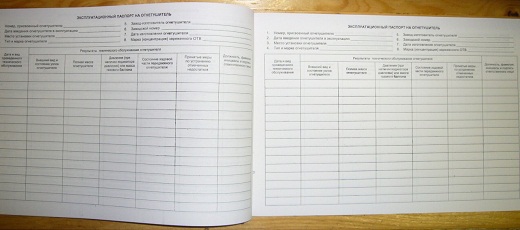
Maintenance log
The fire extinguisher maintenance log includes the results of all checks that the fire extinguisher has undergone over the entire period of operation. Depending on the type of fire extinguisher, the inspection can be carried out either once a season or once a year. The quarterly check includes a superficial inspection of the fire extinguisher body and the place where it is located. Every year, in addition to the above points, the total mass of the fire extinguisher is checked. Fire extinguishers tend to lose weight within acceptable limits. But if the mass level is significantly lower than stated in the operational passport, then this indicates a malfunction of the fire extinguisher. In case of non-compliance with certain standards, an unscheduled reloading of the fire extinguisher is carried out. All maintenance data is recorded in the appropriate log. The form required to fill out is divided into 7 columns, each of which contains the relevant information:
- The date the fire extinguisher was inspected.
- Evaluation of the appearance of the fire extinguisher.
- Full mass.
- pressure (if the extinguisher is equipped with a pressure indicator) and body mass.
- Evaluation of the chassis, if the fire extinguisher is mobile.
- Measures taken to address identified deficiencies.
- Signature, as well as the surname and initials of the official responsible for the maintenance of the fire extinguisher.
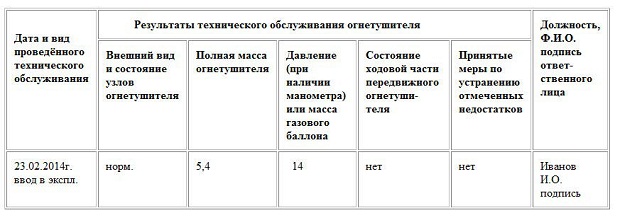
Check log
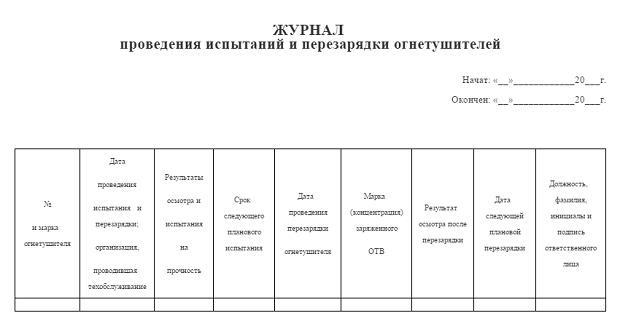
Registration log
The fire extinguisher registration log is a form in which information is entered on:
- fire extinguisher brand
- properties of the fire extinguisher;
- Areas of use;
- storage notes.

Operating passport
Each fire extinguisher has its own passport, which contains all the characteristics of the fire extinguisher, as well as the test results.
The passport form contains such items as:
- Identification number of the fire extinguisher.
- Start date of operation.
- The place where the fire extinguisher was installed.
- Fire extinguisher brand and type.
- The name of the company that manufactured the fire extinguisher.
- Serial number.
- Date of manufacture of the fire extinguisher.
- Extinguishing agent brand.

Certificate of inspection and inspection

write-off act
In the event of the expiration date or breakdown of the fire extinguisher, the management also issues a special act on the write-off of the fire extinguisher.
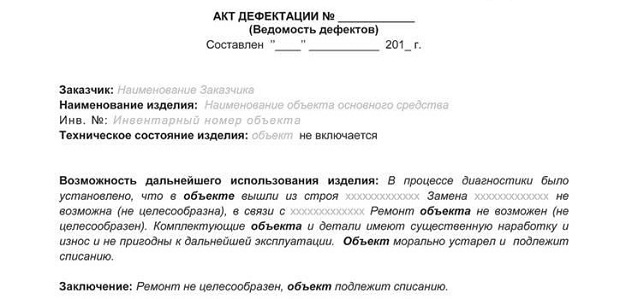
Video
Watch the video for information about fire extinguishers:
When purchasing a fire extinguisher, it is necessary to check all the documentation that came with it. It is these documents that will help to keep a log of fire extinguishers, which will positively affect the level of enterprise security.
According to the order of the Ministry of Emergency Situations of Russia No. 179, from March 25, 2009, the "Requirements for the operation of fire extinguishers and fire equipment" were put into effect. Also, according to the regulatory documents NPB 166-97 " fire fighting equipment. Fire extinguishers, requirements for selection and operation”, which came into force on March 1, 1998.
Example and features of filling
Portable and/or mobile fire extinguishers weighing up to 400 kg and designed to extinguish fires A, B, C, E classes in without fail must have an operational certificate for a fire extinguisher, a sample filling in Fig.1. 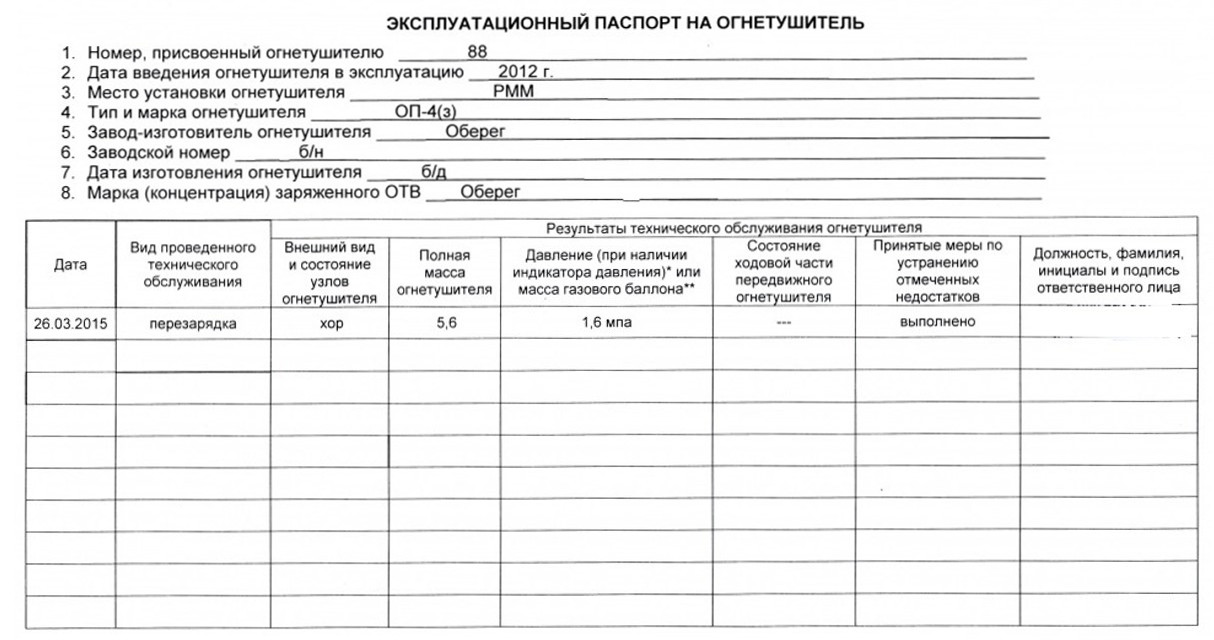
The passport for a fire extinguisher consists of two parts.
- The first part is completed after the equipment is put into operation. In it, the responsible employee of the enterprise, responsible for fire safety in accordance with the order of the organization, once enters the primary data, which are taken from the data sheet attached to the device, where the locations of fire extinguishers and others are marked. The information must correspond to the data entered in the maintenance logs.
- The second part contains a table in which technical information about the state of the device is periodically entered: external data, body damage, filling with fire extinguishing agents, as well as the date of inspection and past maintenance. The information provided must be confirmed by a personal signature and, if available, the seal of an official responsible for fire safety in the organization.
How to correctly fill out a passport for a fire extinguisher that does not have a pressure indicator?
According to the notes to fill out the passport. If there is no pressure gauge on the trigger mechanism or the body of the device that shows the real pressure, or a charge level indicator, the dial of which is divided into zones, then the charge level and the concentration of fire extinguishing agents are determined by the weight of the device, comparing it with the data specified in the technical documentation for the fire extinguisher.
In case of loss of both the operational passport and technical documentation, in order to re-enter the device into operation, a technical verification of the fire extinguisher is carried out by organizations that have the appropriate licenses to carry out such activities. Only after that a new passport is issued, which indicates the data on the fire extinguishing equipment: in the line the manufacturer and the date of manufacture indicate the name of the company that performed the verification and the date of the act of verification work performed.
If you lose your passport, it is allowed independent production according to the prescribed pattern.
Information that is supplemented by the passport during operation
Do I need an operating certificate for a fire extinguisher? In accordance with normative documents, namely paragraph 5.34, NBP 166-97 - it is mandatory to start up for each fire extinguishing agent that is registered for the facility. The use of fire extinguishing equipment without properly completed documentation - passports and magazines in which information is duplicated is not allowed. Documentation contains a variety of data that determine the process of storage and operation of equipment.
The serial number assigned to the fire extinguishing agent is applied to the body with indelible paint or with a reliable sticker. The same number is duplicated in where the availability and technical condition of fire extinguishing equipment registered behind the facility are recorded and checked. 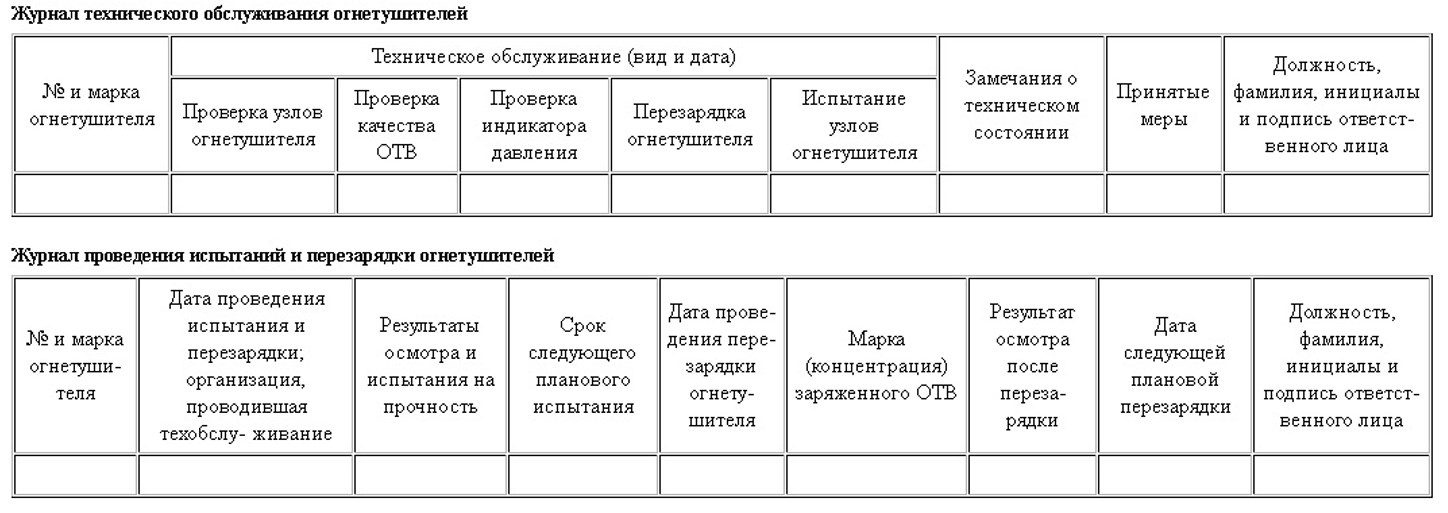
The following information is entered in the passport, and the following information is duplicated in the journals:
- Data on systematic checks of the physical condition of the hull, mechanical damage and defects found, according to paragraph 7.5:
- The presence of labels with instructions and stickers, the condition of the paint on the surface;
- Chips, dents and other damage to the hull;
- If there is a pressure indicator - a pressure gauge, the reliability of the fastening of the device is checked for its integrity and serviceability;
- The presence of a complete set of spraying devices: sockets, hoses, their connection to the cylinder, the state of the material of the sprayers;

- Data on tests of the fire extinguishing device, produced in accordance with paragraph 7.17, determine:
- The presence of defects on the inside of the case. Detection on the surface of corrosion elements, swellings, areas with a peeling protective coating;
- Integrity of gaskets and cuffs;
- Condition of locking mechanisms, filters and internal pressure control devices in the cylinder (if any);
- The integrity of the attachment points of devices for spraying the fire extinguishing mixture - hoses and sockets;
- Recharge data according to paragraph 8.16. The mark is made in the passport, where the date of recharging, weight, volume or concentration of OTV, depending on its type, is entered. A label is attached to the body of the fire extinguisher, where these data are duplicated or a tag indicating that this device has been recharged.
Summing up
Where should a fire extinguisher certificate be kept?
- All technical and operational documentation confirming the suitability of primary fire extinguishing equipment for operation must be kept by responsible person. This employee is appointed by order of the organization and must undergo appropriate training in fire safety courses of the Ministry of Emergencies. About what receives the corresponding document.
- The inventory number and a label with a protective polyethylene coating indicating the date of the last inspection should be placed directly on the fire extinguisher. It must be securely attached to the case so as not to interfere with the use of the device.




